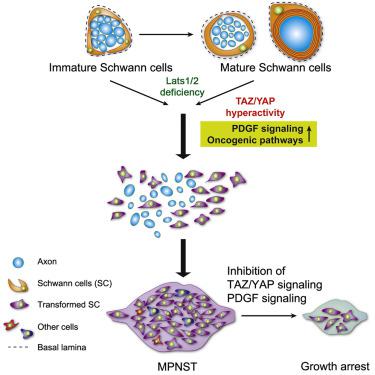当前位置:
X-MOL 学术
›
Cancer Cell
›
论文详情
Our official English website, www.x-mol.net, welcomes your feedback! (Note: you will need to create a separate account there.)
Programming of Schwann Cells by Lats1/2-TAZ/YAP Signaling Drives Malignant Peripheral Nerve Sheath Tumorigenesis.
Cancer Cell ( IF 50.3 ) Pub Date : 2018-02-12 , DOI: 10.1016/j.ccell.2018.01.005 Lai Man Natalie Wu , Yaqi Deng , Jincheng Wang , Chuntao Zhao , Jiajia Wang , Rohit Rao , Lingli Xu , Wenhao Zhou , Kwangmin Choi , Tilat A. Rizvi , Marc Remke , Joshua B. Rubin , Randy L. Johnson , Thomas J. Carroll , Anat O. Stemmer-Rachamimov , Jianqiang Wu , Yi Zheng , Mei Xin , Nancy Ratner , Q. Richard Lu
Cancer Cell ( IF 50.3 ) Pub Date : 2018-02-12 , DOI: 10.1016/j.ccell.2018.01.005 Lai Man Natalie Wu , Yaqi Deng , Jincheng Wang , Chuntao Zhao , Jiajia Wang , Rohit Rao , Lingli Xu , Wenhao Zhou , Kwangmin Choi , Tilat A. Rizvi , Marc Remke , Joshua B. Rubin , Randy L. Johnson , Thomas J. Carroll , Anat O. Stemmer-Rachamimov , Jianqiang Wu , Yi Zheng , Mei Xin , Nancy Ratner , Q. Richard Lu

|
Malignant peripheral nerve sheath tumors (MPNSTs) are highly aggressive Schwann cell (SC)-lineage-derived sarcomas. Molecular events driving SC-to-MPNST transformation are incompletely understood. Here, we show that human MPNSTs exhibit elevated HIPPO-TAZ/YAP expression, and that TAZ/YAP hyperactivity in SCs caused by Lats1/2 loss potently induces high-grade nerve-associated tumors with full penetrance. Lats1/2 deficiency reprograms SCs to a cancerous, progenitor-like phenotype and promotes hyperproliferation. Conversely, disruption of TAZ/YAP activity alleviates tumor burden in Lats1/2-deficient mice and inhibits human MPNST cell proliferation. Moreover, genome-wide profiling reveals that TAZ/YAP-TEAD1 directly activates oncogenic programs, including platelet-derived growth factor receptor (PDGFR) signaling. Co-targeting TAZ/YAP and PDGFR pathways inhibits tumor growth. Thus, our findings establish a previously unrecognized convergence between Lats1/2-TAZ/YAP signaling and MPNST pathogenesis, revealing potential therapeutic targets in these untreatable tumors.
中文翻译:

Lats1 / 2-TAZ / YAP信号传导对许旺细胞的编程可驱动恶性周围神经鞘瘤的发生。
恶性周围神经鞘瘤(MPNSTs)是高度侵袭性的雪旺细胞(SC)谱系来源的肉瘤。驱动SC到MPNST转化的分子事件尚不完全清楚。在这里,我们显示人类MPNSTs表现出高的HIPPO-TAZ / YAP表达,并且由Lats1 / 2丢失引起的SC中的TAZ / YAP过度活跃会强烈诱导出具有高渗透率的高级神经相关肿瘤。Lats1 / 2缺乏症可将SC重新编程为癌性祖细胞样表型,并促进过度增殖。相反,破坏TAZ / YAP活性可减轻Lats1 / 2缺陷小鼠的肿瘤负担,并抑制人MPNST细胞的增殖。此外,全基因组分析显示TAZ / YAP-TEAD1直接激活致癌程序,包括血小板衍生的生长因子受体(PDGFR)信号传导。共同靶向TAZ / YAP和PDGFR途径抑制肿瘤生长。因此,我们的发现在Lats1 / 2-TAZ / YAP信号传导和MPNST发病机理之间建立了以前无法识别的融合,揭示了这些不可治愈的肿瘤中潜在的治疗靶标。
更新日期:2018-02-13
中文翻译:

Lats1 / 2-TAZ / YAP信号传导对许旺细胞的编程可驱动恶性周围神经鞘瘤的发生。
恶性周围神经鞘瘤(MPNSTs)是高度侵袭性的雪旺细胞(SC)谱系来源的肉瘤。驱动SC到MPNST转化的分子事件尚不完全清楚。在这里,我们显示人类MPNSTs表现出高的HIPPO-TAZ / YAP表达,并且由Lats1 / 2丢失引起的SC中的TAZ / YAP过度活跃会强烈诱导出具有高渗透率的高级神经相关肿瘤。Lats1 / 2缺乏症可将SC重新编程为癌性祖细胞样表型,并促进过度增殖。相反,破坏TAZ / YAP活性可减轻Lats1 / 2缺陷小鼠的肿瘤负担,并抑制人MPNST细胞的增殖。此外,全基因组分析显示TAZ / YAP-TEAD1直接激活致癌程序,包括血小板衍生的生长因子受体(PDGFR)信号传导。共同靶向TAZ / YAP和PDGFR途径抑制肿瘤生长。因此,我们的发现在Lats1 / 2-TAZ / YAP信号传导和MPNST发病机理之间建立了以前无法识别的融合,揭示了这些不可治愈的肿瘤中潜在的治疗靶标。



























 京公网安备 11010802027423号
京公网安备 11010802027423号